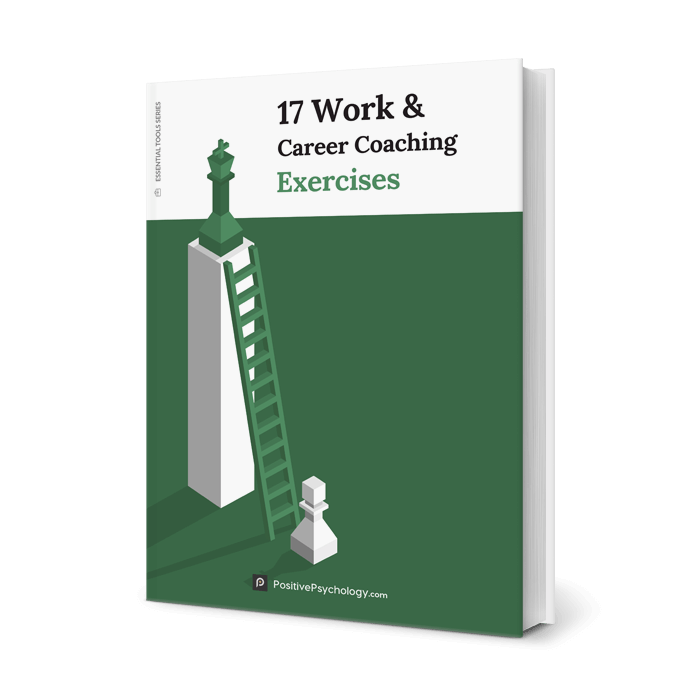How to Perform Assertiveness Training: 6 Exercises
 A lack of assertiveness can leave you feeling like you are no longer living your own life and are nothing more than a puppet, at the mercy of others’ desires.
A lack of assertiveness can leave you feeling like you are no longer living your own life and are nothing more than a puppet, at the mercy of others’ desires.
In contrast, being less anxious and more able to speak up with confidence plays a central role in who you are while safeguarding your mental wellbeing (Hill, 2020).
Assertiveness training helps you understand that it’s okay to say ‘no’ and express your feelings, even if they are unpopular (Speed, Goldstein, & Goldfried, 2018).
In this article, we introduce assertiveness training and share some exercises, tips, and tools to help your client become more assertive without falling into the trap of aggression.
Before you continue, we thought you might like to download our three Work & Career Coaching Exercises for free. These detailed, science-based exercises will help you or your clients identify opportunities for professional growth and create a more meaningful career.
This Article Contains:
- What Is Assertiveness Training?
- 10 Assertive Communication Skills
- 6 Best Assertiveness Training Exercises & Worksheets
- 18 Helpful Assertiveness Training Tips
- Activities for Group Assertiveness Training
- Assertiveness Training in the Workplace 101
- Educating Students and Youth about Assertiveness
- A Take-Home Message
- References
What Is Assertiveness Training?
Assertiveness is associated with behavior that reflects our best interests, “including standing up for oneself without significant anxiety, expressing one’s feelings comfortably, or exercising one’s own rights without denying the rights of others” (Speed et al., 2018, p. 1).
When we lack assertiveness, we find it difficult to stand up for ourselves and assert what we want, need, and feel. And it can manifest in several ways, including excessive agreeableness as well as hostility (Speed et al., 2018).
Types of assertiveness training
In the past, assertiveness training has typically been split into two specialties (Speed et al., 2018):
- Behavioral skills training addresses the skills we lack, exposing us to the stressor to reduce anxiety.
- Cognitive restructuring training targets the anxious thoughts that potentially lead to avoidance behavior.
Assertiveness training currently receives limited research attention, yet a search online and the popularity of assertiveness books suggest its importance to the general population.
A lack of assertiveness is recognized as an essential element of “anxiety, depression, and alcohol/substance abuse disorders” (Speed et al., 2018, p. 9).
While seemingly less prevalent than it used to be, assertiveness training is often found embedded in other larger treatments and potentially labeled differently (Speed et al., 2018):
- Dialectical Behavior Therapy (DBT) for borderline personality disorder strengthens interpersonal effectiveness. This helps people maximize the chance of meeting their objectives or goals without damaging relationships or self-respect.
Indeed, DBT for depression encourages clients to “behave in ways that will get them what they need and want” (Speed et al., 2018, p. 9).
- Acceptance and Commitment Therapy (ACT) promotes committed, value-based actions consistent with the client’s goals despite the risk of failure. ACT encourages change through acceptance of failures and mistakes and a commitment to a suitable chain of actions.
- Cognitive Behavioral Analysis System of Psychotherapy (CBASP) identifies patients with chronic depression as having little awareness of their impact on others, the perception of a lack of control, and feelings of helplessness and hopelessness.
CBASP uses behavioral skills training to help patients notice the “actual (not feared) interpersonal consequences of one’s behavior and increased ability to obtain desired outcomes through assertive action” (Speed et al., 2018, p. 9).
However, there are important considerations regarding the embodiment of assertiveness training in other treatments.
Assertiveness training may not be recognized as a crucial standalone intervention and, because of differing terminology, may not be picked up in literature searches (Speed et al., 2018).
5 Outcomes of assertiveness training
The assertiveness skills acquired in assertiveness training are valuable for both our personal and professional lives, enabling us to find ways to (Shaw, 2020):
- Become our own master and avoid being trampled on.
- Get what we want without being aggressive.
- Reduce stress and gain clarity in interactions by knowing what to accept and when to say ‘no.’
- Improve self-esteem and self-confidence by being more assertive.
- Base decisions on facts by keeping emotions in check.
10 Assertive Communication Skills

Nonverbal skills (including body language) are a valuable way to showcase your assertiveness, especially when you may not get to talk much, or at all. Helpful approaches include (Williams, 2020):
- Stand straight and hold your head high.
- Sit in such a way that you direct your attention to the speaker and make your movements minimal and purposeful.
- Establish your personal space.
- Walk with purpose, showing you know where you are going and how to get there.
- Hand gestures should be chosen, controlled, and reinforce the point you are making.
Body language is typically not enough on its own. Assertiveness must be present in what you have to say (Williams, 2020):
- Be direct without being rude. Say what you mean as clearly as possible.
- Be clear. Say ‘no’ when you are not happy to do something rather than being subtle in your refusal.
- Calm persistence can be powerful. Repeat the point in a non-confrontational way.
- Use “I” statements. Rather than appearing aggressive, say, “I feel,” “I think,” etc.
- Be grateful, appreciative, and apologize when appropriate. Being assertive does not mean you are always right.
There are many exercises that you can use or share with your clients that will help them be assertive without becoming aggressive.
6 Best Assertiveness Training Exercises & Worksheets
Becoming more assertive can be helped by understanding yourself better and building the skills you need (Murphy, 2011).
The following tools and activities will help you or your client turn assertiveness into a habit.
Assertiveness Self-Evaluation Exercise
Self-evaluation is a great place to start when understanding and building assertiveness.
Reflect on each of the questions in the Assertiveness Self-Evaluation Exercise to understand better how assertive you are.
Knowing When to Speak Up
Confidence often begins with knowing when to stand up or speak up for yourself (Hill, 2020).
The Knowing When to Speak Up worksheet asks a series of questions to help you decide whether this is the right time to speak up about something or not.
Finding Your Assertiveness Balance
Respecting yourself and others and finding balance are key to finding your assertiveness sweet spot (Hill, 2020).
Exploring and reflecting upon past behavior can help you develop your assertiveness for the future.
The Finding Your Assertiveness Balance worksheet asks you to think about an earlier event and consider how a passive, assertive, and aggressive response would look. Then you consider how you reacted, before asking yourself how you want to handle such a situation in the future.
How to Get What You Deserve in Life
There is no point in being assertive if you don’t know what you want. Before you ask for something, consider why you want it (Hill, 2020).
The How to Get What You Deserve in Life worksheet asks a series of questions to help you understand and obtain what you want out of life (modified from Hill, 2020).
Respect works in both directions. By preparing to ask for something you deserve, you can handle a request more sensitively.
Self-Assessment for Assertiveness Self-Discovery
Knowing yourself better can help build your assertiveness (Hill, 2020).
The Self-Assessment for Assertiveness Self-Discovery worksheet asks a series of questions to get to know yourself and your assertiveness better.
Use the answers to these questions to recognize all that is good (including people) in your life and how you can improve your assertiveness.
Replace Unhelpful Thoughts for Assertiveness
We often say ‘yes’ to prove our worth. The reasons we agree to something that we want to refuse can result from thoughts and beliefs we learn as we grow up (Shaw, 2020).
The Replace Unhelpful Thoughts for Assertiveness worksheet identifies unhelpful thoughts and considers replacing them with ones more conducive to assertiveness.
Putting in place beliefs and thoughts that support assertiveness can make saying ‘no’ more manageable.
18 Helpful Assertiveness Training Tips

Use the following tips to discuss how to handle typical situations that we face and identify how to be more assertive.
8 Ways to learn how to say ‘no’
Saying ‘no’ is never easy, but there are assertiveness training techniques that can help.
The following tips help to put the ‘no’ out there and make the other person believe they will not be able to change your mind (modified from Williams, 2020):
- Give yourself permission.
Remember that it’s okay to say ‘no.’ - Say ‘no’ positively.
Turn down the request in a positive tone. For example, “I would love to help, but I have already made other commitments.” - Be honest.
Don’t search for or invent an excuse. If you can, say why you are refusing; if not, simply say ‘no.’ - Refuse the request, not the person.
Be specific about what it is you are saying ‘no’ to. - Be timely.
Do not hesitate; be quick, direct, and succinct. - Find a suitable medium.
Saying ‘no’ in person is usually preferable, but occasionally, the best option is by phone, email, or text message. - Explain why.
When people refuse to accept your ‘no’ or keep pushing, explain why you are saying ‘no.’ The reason may have little value to the other person, so remember that it is important to you. - Commit to ‘no.’
If the other person is overly persistent, clarify that you are committed to your refusal. For example, “I have already decided that I can’t do that. Trying to push me will not change my decision.”
In time, assertiveness becomes a habit. Start with the small stuff, and you will be more ready when bigger challenges are presented (Williams, 2020).
Helpful do’s of assertive behavior
Trying to seem assertive is not always the same as being assertive. Without realizing it, you may be displaying aggression.
The following prompts help you reflect on what being assertive means (modified from Williams, 2020; Shaw, 2020):
Assertive people…
- Keep an open mind:
Being assertive should not stop you from listening to and respecting different opinions. - Practice active listening:
Keep an open mind and actively listen to what the other person is saying. - Continue to grow and learn:
Standing by your thoughts does not mean they are right. Consider the evidence. Do you need to revise your opinions? - Handle mistakes positively:
Correct and own up to the mistakes you make. - Express their needs:
Be open, transparent, and direct. - Don’t feel guilty:
Expressing your feelings without aggression is a positive thing to do. - Stand up for what they believe:
Others may disagree, but stand up for yourself and others. - Know their rights:
Become aware of what you are allowed to do, and defend your rights. - Do not confuse assertiveness with aggression:
Being assertive does not mean using aggressive behavior or language. - Have the courage to dream:
Develop the skills to turn your goals into reality.
Create your own list of positive and assertive statements to drive how you act and react in the situations you face.
CBT demo – assertiveness training – Qualia Counselling Services
Activities for Group Assertiveness Training
The following activities are especially valuable in group settings where individuals can share and discuss answers or work together to complete the task (modified from Hill, 2020; Shaw, 2020; Williams, 2020).
Developing an assertive mindset
In a group setting, discuss how to ready yourself for assertiveness at the beginning of the day.
Ask the group to imagine a new day, then answer the following questions:
- What are your fears regarding being assertive today?
- What makes standing up for yourself so difficult?
- Have there been times in the past when people have reacted poorly to your assertiveness?
Ask the group to discuss how being more assertive in the new day would feel and what they could achieve.
Create a list of affirmations
Repeating affirmations is a powerful way to retrain your brain and learn to respond in a more positive way (Hill, 2020).
As a group, create a list of affirmations that may help, such as:
- I am strong and assertive.
- My free time is my own.
- People will respect me for my assertiveness.
- I am responsible for how I behave and how I feel.
Each person then chooses their top three and practices repeating them over the days ahead and in advance of difficult situations.
Assertiveness role-play
Assertiveness is a skill, and like any other, can benefit from practice.
Arrange the group into pairs. Each person takes a turn refusing or declining the other person’s request.
Think of realistic situations, either in the past or future, such as:
I was already overloaded when asked to pick up more work.
I was asked to clear up when we should all be working together.
The requests can be framed in different ways (being demanding, persistent, or subtle), and the other person can practice saying ‘no’ clearly and assertively.
Afterward, discuss as a group what worked well and what was difficult.
Assertiveness Training in the Workplace 101

Self-talk
Positive self-talk can be valuable in many settings, taking back control and shaping our work and relationships (Kross, 2021).
Self-talk can change a negative internal narrative into one that is positive. You can do this through practicing positive and supportive statements, such as (modified from Murphy, 2011):
- I am a strong, confident, and effective communicator.
- I stand up for what I believe in.
- My thoughts, feelings, and emotions are important and deserve to be heard.
Asking for a raise
Asking for a raise at work can be intimidating and uncomfortable, but with the proper tips, it can be easier (Murphy, 2011; Shaw, 2020).
Here are some helpful pointers (modified from Murphy, 2011):
- Book time with your boss and let them know what you would like to discuss. This will allow you both to prepare.
- Identify why you deserve a raise and consider the salaries of others at a similar level of experience and skillset. Websites like Glassdoor can help.
- Put together a list of training and key accomplishments.
- When you walk into the meeting, use assertive body language.
- Use assertive language. Thank them for taking the time to meet you, and then discuss what you are hoping for and the reasons that you deserve the raise.
- Mention any additional duties or roles you are happy to take on.
- Do not pressure for an answer right away; agree to a future meeting.
- If they challenge your request, remain calm while presenting other reasons or examples.
- If they still do not agree to the raise, ask what you can do to increase your chances in the future.
- If the meeting goes poorly, you may need to consider your future with the company and whether it is worthwhile exploring other opportunities.
Educating Students and Youth About Assertiveness
From an early age, it is helpful to recognize the importance of setting and working toward goals.
Setting goals
Goals are motivating, encourage us to learn more, and help us develop. Goals guide our decision making and help us identify when we need to be more assertive (Hill, 2020).
Goals are often more achievable when broken down into smaller steps, with a plan for each one.
Understanding boundaries
Identifying and adhering to boundaries can be difficult at any age, especially when we are young (Hill, 2020).
Discuss with the young person what their boundaries are in the situations they face.
- Physical boundaries:
Personal space and body. - Emotional boundaries:
Being comfortable with and connected to their feelings. - Sexual boundaries:
What is and is not acceptable, and when they want to say ‘no.’ - Intellectual boundaries:
Respecting others’ opinions and beliefs, and expecting respect from others.
Dealing with criticism
It is never easy being told we have done something wrong. However, if we can take the feedback constructively, it can be a positive way to learn and build confidence (Williams, 2020).
Discuss the following guidelines to see how having a positive mindset can help:
- Try not to react too quickly, and keep emotions in check.
- When there is a misunderstanding, correct it calmly and rationally.
- When given feedback, don’t assume everything is wrong. Get down to the single point or issue.
- Ask if a compromise can be reached. Come up with some of your own.
- Don’t take criticism personally. It is about something you have done or not done, rather than who you are.
Sometimes taking a deep breath and focusing on what is really being said, rather than what you expect to hear, can be a powerful assertiveness training technique for growth and development.
A Take-Home Message
It’s okay to say ‘no.’ You may feel pressured to comply and do what others ask, even if it feels uncomfortable, but you have permission to refuse (Speed et al., 2018).
Being assertive is an essential factor in becoming less anxious and a solid commitment to your mental wellbeing.
Assertiveness training can help you gain the tools and skills to say ‘no’ to the request while showing respect to that person. It need not be aggressive, but needs to be clear and convincing (Shaw, 2020).
Adopting assertive body language and verbal communication is essential, as are timing and being committed to your response.
With an open mind and a willingness to learn, it is possible to hear the other person’s needs, reach compromises where appropriate, and continue our journey to our goals.
Try out some of the assertiveness training exercises along with the worksheets. By understanding your assertiveness (or lack thereof), you can identify where development is needed, using the worksheets as your guide.
We hope you enjoyed reading this article. Don’t forget to download our three Work & Career Coaching Exercises for free.
- Gallo, A. (2012, August 21). How to be assertive (without losing yourself). Harvard Business Review. Retrieved June 11, 2021, from https://hbr.org/2012/08/how-to-be-assertive-without-lo
- Hill, C. (2020). Assertiveness training: How to stand up for yourself, boost your confidence, and improve assertive communication skills. Author.
- Kross, E. (2021). Chatter: The voice in our head and how to harness it. Vermilion.
- Murphy, J. (2011). Assertiveness: How to stand up for yourself and still win the respect of others. Author.
- Shaw, G. (2020). Alpha assertiveness guide for men and women: The workbook for training assertive behavior and communication skills to live bold, command respect and gain confidence at work and in relationships. Communication Excellence.
- Speed, B. C., Goldstein, B. L., & Goldfried, M. R. (2018). Assertiveness training: A forgotten evidence-based treatment. Clinical Psychology: Science and Practice, 25(1).
- Williams, J. W. (2020). Assertiveness training: Stop people pleasing, feeling guilty, and caring for what others think, and start speaking up, saying no, and being more confident. Author.
Let us know your thoughts
Read other articles by their category
- Body & Brain (50)
- Coaching & Application (57)
- Compassion (26)
- Counseling (51)
- Emotional Intelligence (24)
- Gratitude (18)
- Grief & Bereavement (21)
- Happiness & SWB (40)
- Meaning & Values (26)
- Meditation (20)
- Mindfulness (45)
- Motivation & Goals (45)
- Optimism & Mindset (34)
- Positive CBT (29)
- Positive Communication (20)
- Positive Education (47)
- Positive Emotions (33)
- Positive Leadership (18)
- Positive Parenting (4)
- Positive Psychology (33)
- Positive Workplace (37)
- Productivity (17)
- Relationships (46)
- Resilience & Coping (38)
- Self Awareness (21)
- Self Esteem (38)
- Strengths & Virtues (32)
- Stress & Burnout Prevention (34)
- Theory & Books (46)
- Therapy Exercises (37)
- Types of Therapy (64)





What our readers think
Very helpful and covers most things
Thank you for this insightful and brilliant article, it has transformed me, my attitude, and my perceptions. My confidence level is restored, and I am glad I can now express myself better. Thank you.
After reading through the article, I come to the realisation that saying NO is not really a negative response because in the past, I have said yes to almost everything including things I should have said no to. This in turn became a burden which made me feel anxious and affected my mental state and well-being. With the help of this article, I will be able to say no constructively and calmly without being aggressive.
It is very powerful and highly effective article. All of the activities you have shared are inspirational and empowering. Thank you for that.
Thank you so much for putting this – and the related PDFs for download – out there. I am a people-pleaser and I really struggle to say no. I am now suffering with burn-out and have had to take time off work to recover. I work with a range of people who manipulate and make saying ‘no’ very difficult, while also over-loading me with tasks they don’t want to do. I have really found this work useful and will continue to work on my own assertiveness. Thank you.
Very helpful and insightful. Everything you have shared here. I am confident to begin applying in how I communicate with others while showing respect for myself. Thank you for sharing. Best wishes to all your endeavors.
THANK YOU VERY MUCH INDEED for this excellent article! Some of these hints I have discovered myself (painfully, by trial-and-error), most of them not. I wish you much happiness, Mira, Pilsen, Czech Republic (age 46 )